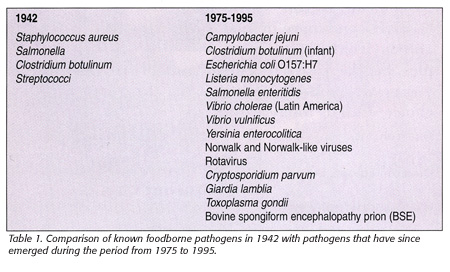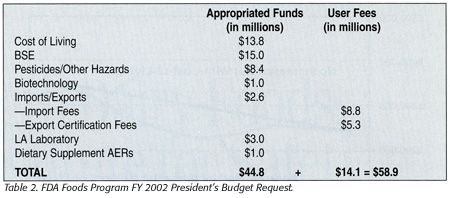Foodborne illness is a compelling and real public health problem. The Centers for Disease Control and Prevention (CDC) has estimated that foodborne diseases cause approximately 76 million illnesses, 325,000 hospitalizations, and 5,000 deaths in the United States each year. Many changes are contributing to this problem. Today, people are eating a greater variety of foods, particularly seafood and fresh fruits and vegetables that are eaten raw. Second, advances in transportation and refrigeration have brought us a greater variety of foods during all seasons of the year, from all around the world. The rising amount of imported foods dramatically increases the number of potential sources of food contamination. Third, people are eating more of their meals away from home. In fact, fifty cents of every food dollar is spent on food prepared outside the home where more food workers become involved in preparing our food, cooking our food, and serving our food. This problem is especially important for those persons at greatest risk for foodborne illness who eat foods prepared in hospitals, nursing homes and daycare centers. Persons at highest risk for foodborne illness—pregnant women, the very young, the elderly and those with compromised immune systems—now account for nearly one quarter of the population.
 But the most critical element in our changing world is the emergence of new foodborne pathogens and the ability of existing pathogens to overcome traditional food safety barriers such as temperature and acidity. Today, we are aware of more than five times the number of foodborne pathogens than were known about in 1942 (Table 1). Many of these pathogens can be deadly, especially for people at highest risk. A strong scientific foundation is critical to meeting these challenges and continuing to ensure the safety of the food supply.
But the most critical element in our changing world is the emergence of new foodborne pathogens and the ability of existing pathogens to overcome traditional food safety barriers such as temperature and acidity. Today, we are aware of more than five times the number of foodborne pathogens than were known about in 1942 (Table 1). Many of these pathogens can be deadly, especially for people at highest risk. A strong scientific foundation is critical to meeting these challenges and continuing to ensure the safety of the food supply.
FARM-TO-TABLE STRATEGY
In May 1997, the federal government announced a comprehensive new food safety strategy to reduce the incidence of foodborne illness due to microbial contamination. This government-wide initiative aimed to improve food safety practices and policies throughout the entire food production chain—i.e., from “farm-to-table.” Throughout the food production chain, efforts to reduce microbial contamination will be most successful when prevention-oriented process controls are put in place. However, prevention efforts can never be expected to eliminate all cases of foodborne illness. Therefore, the farm-to-table continuum also focuses on early detection and containment of outbreaks and effective traceback efforts.
Since inception of the food safety initiative, the U.S. Food and Drug Administration (FDA) and the other participating agencies such as CDC and the U.S. Department of Agriculture (USDA) have successfully built a strong foundation for a state-of-the-art, science- based food safety system that will drive future progress for years to come. This foundation includes the surveillance systems that have been put in place—FoodNet, PulseNet and NARMS— through CDC; preventive controls such as Hazard Analysis & Critical Control Points (HACCP) systems for seafood, meat and poultry, and juice; research and risk assessment, which provides the strong scientific basis necessary for effective regulatory programs; education programs for consumers, food producers, foodservice workers and public health professionals; and interagency and federal/state partnerships that have been formed to more efficiently utilize our collective resources. Over the past several years, FDA, in collaboration with the other federal agencies, as well as our state and local counterparts, has made great strides in improving the safety of the nation’s food supply. Through the FoodNet surveillance system, CDC has documented reductions in foodborne illness for a number of important food pathogens.
FDA PREVENTION PROGRAMS
Prevention is the cornerstone of FDA’s efforts to reduce foodborne illness in this country. FDA’s prevention programs include the seafood HACCP program; the Good Agricultural Practices (GAP) program for fresh produce; a program to reduce foodborne illness associated with fresh spouts; a greatly expanded import surveillance program; the Food Code, which serves as model state legislation for safe food handling at retail; and monitoring for antimicrobial resistance in food-producing animals.
Moreover, this past year, we have taken a number of important steps to enhance food safety. In December 2000, FDA issued a final regulation requiring safe handling information for consumers and new refrigeration requirements to help prevent foodborne illness from shell eggs contaminated with Salmonella Enteritidis (SE). In January 2001, FDA published a final HACCP rule to increase the safety of fruit and vegetable juices. In January 2001, in collaboration with USDA, FDA published a draft risk assessment that examined the risk of foodborne listeriosis from eating certain ready-to-eat foods, as well as a draft Action Plan designed to reduce the risk of foodborne illness due to Listeria monocytogenes. FDA published a second draft risk assessment in January 2001 on the public health risks associated with consumption of raw oysters containing pathogenic Vibrio parahaemolyticus. Data from these risk assessments provide a scientific framework for developing health- improving food safety policy.
In collaboration with USDA, CDC and FDA, the American Medical Association (AMA) recently developed an educational program for physicians on foodborne illness. This program is intended to provide physicians with current guidelines for the diagnosis, treatment, reporting and prevention of food- borne illness. It also provides physicians with information they can provide to patients on prevention of foodborne illness.
FDA’s recent food safety accomplishments also include advice to consumers on the risks associated with eating fish that contain high levels of methylmercury; a proposed rule to more effectively prevent unsafe imported food from entering the U.S.; a proposed rule and draft guidance document concerning food developed through biotechnology; a “channels of trade” guidance for industry on food containing residues of the pesticide methyl parathion; and guidance to the industry on testing finished food products for the presence of StarLinkTM corn. In all of these important areas, we are proud that our food safety programs are science-based and are supported by a rigorous foundation of high-quality research and risk assessment.
PRESIDENT’S 2002 BUDGET REQUEST
The President’s FY 2002 Budget Request, released on April 9, 2001, includes a significant increase for FDA’s foods program. These added funds would account for a $59 million, or 160/0, increase to FDA’s existing foods program budget (Center for Food Safety and Applied Nutrition, Center for Veterinary Medicine, and the corresponding parts of FDA’s field activities).
 Table 2 highlights information in the President’s Budget Request for FDA’s Foods Program.
Table 2 highlights information in the President’s Budget Request for FDA’s Foods Program.
 One of the most significant items in the President’s FY 2002 Budget is finding for mandatory or cost-of-living increases. FDA has not received a cost- of-living increase for nearly a decade. This means that, in each year, as costs go up, available dollars have gone down. Figure 1 shows that, after several years of program “increases,” FDA’s foods program is only now catching up to what the budget would have been, without any program increases, if the agency had just received finding for annual cost-of living expenses.
One of the most significant items in the President’s FY 2002 Budget is finding for mandatory or cost-of-living increases. FDA has not received a cost- of-living increase for nearly a decade. This means that, in each year, as costs go up, available dollars have gone down. Figure 1 shows that, after several years of program “increases,” FDA’s foods program is only now catching up to what the budget would have been, without any program increases, if the agency had just received finding for annual cost-of living expenses.
ISSUES ON THE HORIZON
Important initiatives for FDA in the coming months include a reexamination of our programs to ensure they are as strong as possible in order to prevent bovine spongiform encephalopathy (BSE) from entering the U.S. food supply; the development of proposed egg safety standards to prevent SE at the farm and at retail establishments; implementing a “mid-course correction” to further strengthen our seafood HACCP program to focus on products that present the highest risk to consumers; adoption of a proposed control plan to reduce Vibrio vulnificus-related illness associated with consumption of raw shellfish; and expansion of the food safety program beyond microbiological hazards to include chemical contaminants, pesticide contamination, and other food hazards, including food allergens.
In the long-term, FDA will be working with our federal and state partners, as well as academia, industry, consumer organizations and Congress, to build a strong and credible food safety system. Characteristics of a strong and credible food safety system include: (1) scientific expertise with worldwide stature; (2) utilization of a risk-based approach; (3) establishment of a credible domestic inspection and sampling presence; (4) assuring the same level of protection for imported food products; (5) ability to steward new technologies, such as new packaging materials and/or processing methodologies, that are intended to decrease the incidence of foodborne illnesses; and (6) utilizing effective consumer education and risk communication.
A strong and credible food safety system will have two important results: safe and confident consumers and a globally competitive industry. We must all work together to achieve that goal.
Joseph A. Levitt is Director, Center for Food Safety and Applied Nutrition, U S. Food and Drug Administration. This article is based on his keynote presentation made at the Food Safety Summit, cosponsored by the National Food Processors Association and Food Safety Magazine, held in Washington, DC, April 2001.
ACKNOWLEDGMENT
The author wishes to acknowledge Tracy Summers for her assistance in preparing this manuscript.
FDA Reorganizes Office of Premarket Approval
The FDA Center for Food Safety and Applied Nutrition Office of Premarket Approval began operating under a restructured program June 18, 2001 The reorganized program will now be known as the Office of Food Additive Safety (OFAS). Alan M, Rulis, Ph.D., will remain as director of the program.
The major operational units of the OFAS are the Divisions of Food Contact Substance Notification Review; Petition Review, Biotechnology and GRAS Notice Review; and Chemistry Research and Environmental Review.
A “Dear Colleague Letter” and a full chart summarizing the changes is available at www.cfsan.fda.gov/~dms/opare-org.html.
>



